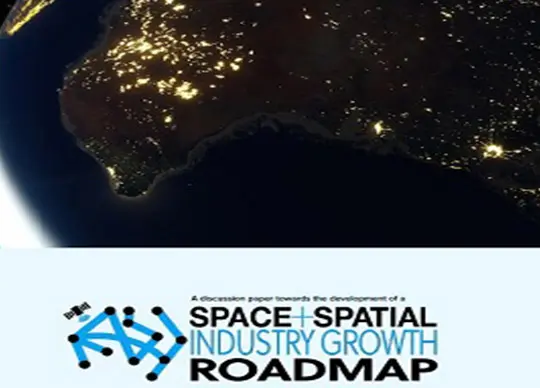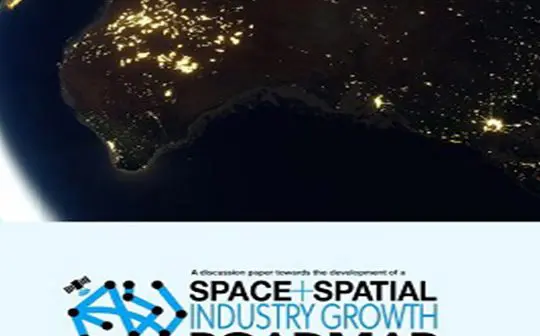
A national coalition of leading space and geospatial industry experts have launched the 2030 Space+Spatial Industry Growth Roadmap, an industry document designed to inform government policymakers to commit to an integrated space and spatial industry to safeguard Australia’s future economic success, societal well-being, and national security.
The 2030 Space+Spatial Industry Growth Roadmap lists nine key objectives that must be met to future-proof the nation’s sovereign capabilities in these two vitally important industries – with wide-ranging consequences for tackling climate change, enhancing disaster resilience, strengthening defence, and safeguarding our most critical infrastructure.
The Roadmap was developed from extensive industry-wide consultation over 18 months under the leadership of the late Dr Peter Woodgate. It was officially handed over to the Australian Space Agency today as input to its 2040 Vision Roadmap.
Acting Chair of the 2030 Space+Spatial Steering Committee, Glenn Cockerton, said the simultaneous growth of the space and spatial industries would profoundly impact the nation’s well-being over the next decade and beyond.
“The 2030 Space+Spatial Roadmap represents the lasting legacy of Dr Peter Woodgate and aims to help Australia take advantage of a golden opportunity to bring our national space and spatial industries closer together. The businesses at the intersection of space and spatial have a fundamental role in helping Australia navigate its response to catastrophic bushfires, the impacts of climate change, and the development of recovery plans for the economy following the global pandemic and its impact on our society and the economy.”
“This work was conducted under Dr Woodgate’s leadership and was the culmination of over the last few years working across the space, spatial and research sectors. We are proud to be handing over these recommendations to the Australian Space Agency today and hope that the roadmap inspires government at all levels to take immediate action,” he added.
The objectives detailed in the Roadmap are:
- Establishing an overarching space and spatial strategy
- Driving sustainable long-term growth by developing local space and spatial companies
- Improving the coordination of publicly funded research in the sector
- Driving high-tech employment opportunities by building space and spatial skills capacity
- Building Australia’s sovereign capability in Spatial Digital Twins* as a critical national capability
- Upgrading Australia’s PNT capabilities and technologies
- Reducing sovereign risks to Australia’s critical space and spatial infrastructure, systems and data
- Supporting our space and spatial industries to better meet the Defence needs of Australia
- Maintaining and enhancing Australia’s national map base
The objectives align with and support the existing strategy of the Australian Space Agency, showcasing practical examples of how merging the space and spatial industries and providing increased oversight, funding and support will contribute to achieving the government’s goal of industry growth to AU$10 billion within the decade.
Chair of the SIBA-GITA Board, Alistair Byrom, said the organisation strongly supports the recommendations and looks forward to contributing further to its implementation.
“The 2030 Space+Spatial Industry Growth Roadmap is to be lauded – the key recommendations, when implemented, will go a long way to delivering the significant growth potential of the space and spatial industries and provide tangible and valuable critical outcomes for Australia.”
Tony Wheeler, Chief Executive Officer of the Surveying and Spatial Sciences Institute, believes technological change presents an opportunity for space and spatial businesses to work together to integrate information workflows faster and cheaper.
“With the Fourth Industrial revolution upon us, it is driving an economy-wide digital transformation that is changing how we work. It is characterised by knowledge derived from data, networks, and powerful tools – merging human, physical and digital environments.
“With a significant component of the space economy being applications, data and information delivered from space and spatial applications are crucial. This will improve the service offerings and productivity overall, which likely positively impact at least 75 per cent of the nation’s economy and is a vital part of our emerging digital economy.”
The roadmap has been shaped by extensive industry-wide consultation led by peak bodies, including the Spatial Industries Business Association – Geospatial Information and Technology Association, the Surveying and Spatial Sciences Institute and Earth Observation Australia.
The consultation included feedback from the Australian Space Agency, the Australia and New Zealand Land Information Council, the Department of Defence, Geoscience Australia, the Bureau of Meteorology CSIRO, SmartSat CRC and FrontierSI.
You can read the full report here.





